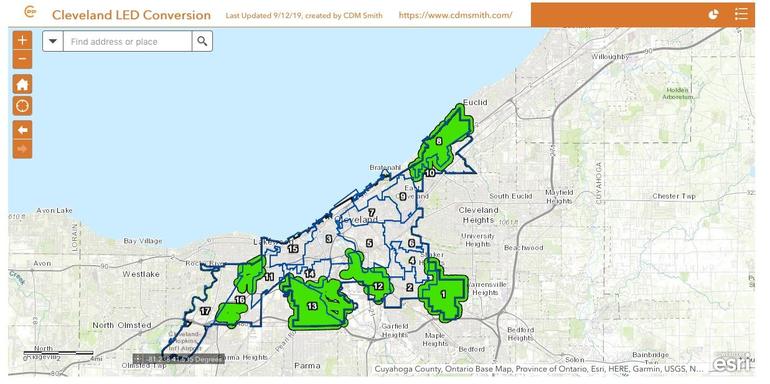↑ Cleveland Public Power updates this map weekly to show progress in the Smart Safe CLE project. Image: Cleveland Public Power

Smart lighting is perhaps a less sexy area of area of smart city investment. Good to see that Cleveland is reaping the benefits

by Veronica Combs – 23 Sept. 2019
Cleveland’s smart streetlights project builds smart city backbone
61,000 lights will get LEDs and remote controls in $35 million upgrade in Cleveland, Ohio when city leaders flip the switch on Smart, Safe CLE.
The streets of Cleveland, Ohio are going to be a whole lot smarter when city leaders flip the switch on Smart, Safe CLE . Cleveland and ST Engineering Telematics Wireless are working on a plan to convert the city’s 61,000 street lights into a smart network.
The project has the potential to reduce annual streetlight operating costs by as much as 20%. The standard street light bulbs will be replaced by LEDs which could cut the city’s annual electric bill by another 50%.
In Los Angeles, the city began swapping out all of its old sodium-vapor streetlights with LEDs and by 2016, with 80% of the lights replaced, the city was saving nearly $9 million annually on energy costs. This easily covered the initial installation cost of $57 million for the streetlights for a no-brainer ROI, as previously reported in TechRepublic.
In addition to saving money, this new network will provide a generic backbone that can be used for other smart city projects. The project will take about 18 months and cost $35 million. The communications infrastructure was installed in three days and is already complete. The Cleveland Power Company has an online map that tracks the LED conversion progress.
Telematics installed a T-Light Galaxy Network which provides web-based control of the light fixtures and the network. This wide-area network uses a single base station to covers an area of up to 20 km radius and monitors up to 50,000 lights.
The new system includes:
- Remote control of individual lights and groups of lights
- Pre-programmed schedules for routine and real time management for special events
- Full over-the-air firmware upgrade capability.
- Maintenance alerts in real time
The company’s BrightCity software controls each streetlight’s operation and allows lights to be set at different intensities for residential, commercial and industrial locations. In addition to converting the streetlights, Telematics will install 1,000 cameras to be operated by the Cleveland Police Department in locations identified by the police as crime “hot spots,” as well as within 1,000 feet of recreation centers and parks.
Telematics also will install three gateways to cover the entire city’s network of streetlights, and a fourth gateway is planned for city-wide redundant coverage. Telematics Wireless is a fully owned subsidiary of Singapore Technologies Electronics.
Barriers to LED street lights
Saving money by switching to LED lights seems like a no-brainer but there’s always enough politics in a city project to get in the way of a good idea. Modernizing street lights is difficult to do because utility companies own 60% of the street lighting in the country. Helping cities lower their utility bills is a direct hit to the power company’s bottom line.
The City of Albany, New York had to buy its 10,313 street lights from a utility for $9.4 million to make the LED conversion.
The Better Buildings Initiative created an “Outdoor Lighting Accelerator Toolkit” with information on how to address technical, financial and regulatory barriers to transitioning to smart street lights.

There are more publicly owned power companies in America than privately owned, but the investor-owned utilities are bigger. The city owns Cleveland Public Power, which is a Division of the Department of Public Utilities. The city-owned power company started delivering power to city residents in 1906 and survived a takeover attempt in 1979 by a investor-owned electric utility. Today the power company is the biggest publicly owned power company in Ohio.
Cleveland universities lead IOT Collaborative
The streetlight project is part of the Smart City Cleveland plan. The city released its strategic plan in 2016 with five strategic focus areas: traffic, transit, sensing, grids and communication. The project’s goal is to use technology to improve public safety, increase access to education and services by improving mobility, all while reducing greenhouse gas emissions. Case Western Reserve University launched the Institute for Smart, Secure and Connected Systems (ISSACS) to study the Industrial Internet of Things.
The smart cities work got a boost in 2017 when Case Western Reserve University and Cleveland State University founded the IoT Collaborative. The collaborative is working with industrial, governmental, educational, neighborhood and non-profit groups to test IoT devices and projects related to smart city, health care, energy and other areas.
View original article at www.techrepublic.com



Recent Comments